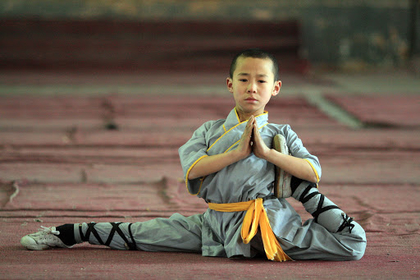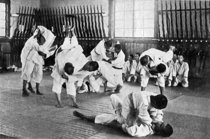
Karate
(Okinawan pronunciation: ) is a martial art developed in the Ryukyu Kingdom. It developed from the indigenous Ryukyuan martial arts (called "hand"; tii in Okinawan) under the influence of Kung Fu, particularly Fujian White Crane. Karate is now predominantly a striking art using punching, kicking, knee strikes, elbow strikes and open-hand techniques such as knife-hands, spear-hands and palm-heel strikes. Historically, and in some modern styles, grappling, throws, joint locks, restraints and vital-point strikes are also taught. A karate practitioner is called a . The Empire of Japan annexed the Ryukyu Kingdom in 1879. Karate came to the Japanese archipelago in the early 20th century during a time of migration as Ryukyuans, especially from Okinawa, looked for work in Japan. It was systematically taught in Japan after the Taishō era of 1912-1926. In 1922 the Japanese Ministry of Education invited Gichin Funakoshi to Tokyo to give a karate demonstration. In 1924 Keio University established the first university karate club in mainland Japan, and by 1932 major Japanese universities had karate clubs. In this era of escalating Japanese militarism, the name was changed from ("Chinese hand" or "Tang hand") to ("empty hand") – both of which are pronounced karate in Japanese – to indicate that the Japanese wished to develop the combat form in Japanese style. After World War II, Okinawa became (1945) an important United States military site and karate became popular among servicemen stationed there. The martial-arts movies of the 1960s and 1970s served to greatly increase the popularity of martial arts around the world, and English-speakers began to use the word karate in a generic way to refer to all striking-based Asian martial arts. Karate schools began appearing across the world, catering to those with casual interest as well as those seeking a deeper study of the art. Shigeru Egami, Chief Instructor of Shotokan Dojo, opined that "the majority of followers of karate in overseas countries pursue karate only for its fighting techniques ... Movies and television ... depict karate as a mysterious way of fighting capable of causing death or injury with a single blow ... the mass media present a pseudo art far from the real thing." Shōshin Nagamine said: "Karate may be considered as the conflict within oneself or as a life-long marathon which can be won only through self-discipline, hard training and one's own creative efforts." On 28 September 2015 karate featured on a shortlist (along with baseball, softball, skateboarding, surfing, and sport climbing) for consideration for inclusion in the 2020 Summer Olympics. On 1 June 2016 the International Olympic Committee's executive board announced they were supporting the inclusion of all five sports (counting baseball and softball as only one sport) for inclusion in the 2020 Games. Web Japan (sponsored by the Japanese Ministry of Foreign Affairs) claims that karate has 50 million practitioners worldwide, while the World Karate Federation claims there are 100 million practitioners around the world.
See all
0
Kenpō
is the name of several Japanese martial arts. The word kenpō is a Japanese translation of the Chinese word "quánfǎ". This term is often informally transliterated as "kempo", as a result of applying Traditional Hepburn romanization, but failing to use a macron to indicate the long vowel. The generic nature of the term combined with its widespread, cross-cultural adoption in the martial arts community has led to many divergent definitions. The word Kenpō translates thus: "Ken" meaning 'Fist' and "Po" meaning 'Method' or 'Law' as in 'Law of gravity', a correct interpretation of the word Kenpō would be 'Fist Method', the same meaning as 'Quanfa'. However, it is often misinterpreted as 'the Law Of The Fist' , which appeals to those looking for a more 'imposing' or aggressive sounding name.
See all
0
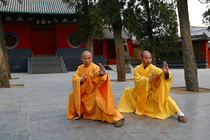
Kung fu
In general, kung fu/kungfu refers to the Chinese martial arts, also called wushu and quanfa.
0
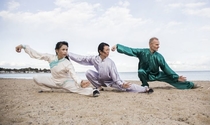
Tai chi
Tai chi , short for T'ai chi ch'üan or Tàijí quán (太極拳), is an internal Chinese martial art practiced for both its defense training, its health benefits and meditation. The term taiji is a Chinese cosmological concept for the flux of yin and yang, and 'quan' means fist. So, etymologically, Taijiquan is a fist system based on the dynamic relationship between polarities (Yin and Yang). Though originally conceived as a martial art, it is also typically practiced for a variety of other personal reasons: competitive wrestling in the format of pushing hands (tui shou), demonstration competitions and achieving greater longevity. As a result, a multitude of training forms exist, both traditional and modern, which correspond to those aims with differing emphasis. Some training forms of tai chi are especially known for being practiced with relatively slow movements. Today, tai chi has spread worldwide. Most modern styles of tai chi trace their development to at least one of the five traditional schools: Chen, Yang, Wu (Hao), Wu and Sun. All of the former, in turn, trace their historical origins to Chen Village.
See all
0
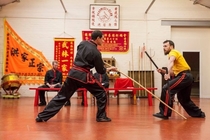
Hung Ga
Hung Ga (洪家), Hung Kuen (洪拳), or Hung Ga Kuen (洪家拳) is a southern Chinese martial art (Cantonese, to be more specific) belonging to the southern shaolin styles. It is associated with the Cantonese folk hero Wong Fei Hung, a Hung Ga master. The hallmarks of the Wong Fei-Hung lineage of Hung Ga are deep low stances, notably the "sei ping ma" (四平馬) horse stance, and strong hand techniques, notably the bridge hand and the versatile tiger claw. Traditionally, students spent anywhere from several months to three years in stance training, often sitting only in horse stance from half an hour to several hours at a time, before learning any forms. Each form could then take a year or so to learn, with weapons learned last. In current times, this mode of instruction is generally considered impractical for students, who have other concerns beyond practicing kung fu. However, some instructors still follow traditional guidelines and make stance training the majority of their beginner training. Hung Ga is sometimes mis-characterized as solely external—that is, reliant on brute physical force rather than the cultivation of qi—even though the student advances progressively towards an internal focus. {| cellpadding=3px cellspacing=0px bgcolor=#f7f8ff style="float:right; border:1px solid; margin:5px" |colspan=2 align=center style="border-top:1px solid;font-size:36px;line-height:40px"|洪拳 |- !style="background:#ccf; border-bottom:1px solid" colspan=2|Hung Kuen |- |align=right|Pinyin:||Hóng Quán |- |align=right|Yale Cantonese:||Hùhng Kyùhn |- |align=right|Literally||"immense fist" |- |}
See all
0
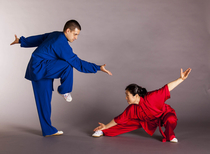
Baguazhang
Baguazhang or Pakwachang is one of the three main Chinese martial arts of the Wudang school, the other two being T'ai chi and Xing Yi Quan. It is more broadly grouped as an internal practice (or neijia quan). Bāguà zhǎng literally means "eight trigram palm," referring to the trigrams of the I Ching (Yijing), one of the canons of Taoism.
See all
0
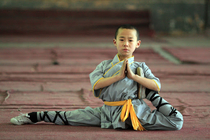
Shaolin Kung Fu
Shaolin Kung Fu , also called Shaolin Wushu or Shaolin quan , is one of the oldest, largest, and most famous styles of wushu or kungfu. It combines Ch'an philosophy and martial arts and originated and was developed in the Shaolin temple in Henan province, China during its 1500-year history. Popular sayings in Chinese folklore related to this practice include "All martial arts under heaven originated from Shaolin" and "Shaolin kung fu is the best under heaven," indicating the influence of Shaolin kung fu among martial arts. The name Shaolin is also used as a brand for the so-called external styles of kung fu. Many styles in southern and northern China use the name Shaolin.
See all
0
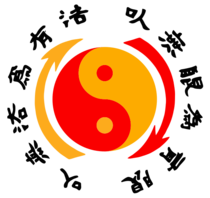
Jeet Kune Do
Jeet Kune Do , or "The way of the intercepting fist" in Cantonese, abbreviated JKD, is a hybrid philosophy of martial arts heavily influenced by the personal philosophy and experiences of martial artist Bruce Lee. Lee founded the system on July 9, 1967, referring to it as "non-classical", suggesting that it is a formless form of Chinese Kung Fu. Unlike more traditional martial arts, Jeet Kune Do is not fixed or patterned and is a philosophy with guiding ideas. Named for the Wing Chun concept of interception or attacking when one's opponent is about to attack, Jeet Kune Do's practitioners believe in minimal effort with maximum effect and extreme speed. On January 10, 1996, the Bruce Lee Foundation decided to use the name Jun Fan Jeet Kune Do (振藩截拳道) to refer to the martial arts system which Lee founded; "Jun Fan" being Lee's Chinese given name. It is referenced in the screenplay of the 1973 Warner Brothers film Enter the Dragon, when Lee is asked, "What's your style?", he replies, "My style?...You can call it the art of fighting without fighting."
See all
0
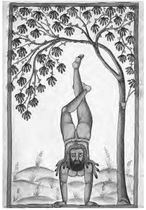
Varma Ati (Martial Arts)
Tamil term literally translated as “hitting the vital spots.” Also known as ati murai (the law of hitting/attacking) and ati tata (hit/defend), as well as chinna ati (Chinese hitting), varma ati is the martial system practiced in the South Travancore
0
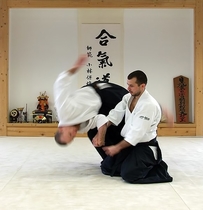
Aikido
is a modern Japanese martial art developed by Morihei Ueshiba as a synthesis of his martial studies, philosophy and religious beliefs. Ueshiba's goal was to create an art that practitioners could use to defend themselves while also protecting their attackers from injury. Aikido is often translated as "the way of unifying (with) life energy" or as "the way of harmonious spirit". Aikido's techniques include: irimi (entering), and tenkan (turning) movements (that redirect the opponent's attack momentum), and various types of throws and joint locks. Aikido derives mainly from the martial art of Daitō-ryū Aiki-jūjutsu, but began to diverge from it in the late 1920s, partly due to Ueshiba's involvement with the Ōmoto-kyō religion. Ueshiba's early students' documents bear the term aiki-jūjutsu. Ueshiba's senior students have different approaches to aikido, depending partly on when they studied with him. Today, aikido is found all over the world in a number of styles, with broad ranges of interpretation and emphasis. However, they all share techniques formulated by Ueshiba and most have concern for the well-being of the attacker.
See all
0
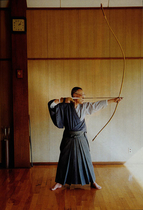
Kyūdō
Kyūdō (弓道) is the Japanese martial art of archery. Experts in kyūdō are referred to as . Kyūdō is based on kyūjutsu ("art of archery"), which originated with the samurai class of feudal Japan. Kyūdō is practised by thousands of people worldwide. As of 2005, the International Kyudo Federation had 132,760 graded members.
See all
0
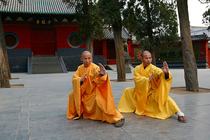
Chin Na
Qinna is the set of joint lock techniques used in the Chinese martial arts to control or lock an opponent's joints or muscles/tendons so he cannot move, thus neutralizing the opponent's fighting ability. Qinna Shu (meaning "technique") literally translates as lock catch technique. Some schools simply use the word na ("hold") to describe the techniques. Qinna features both standing and ground-based grappling techniques. Some Chinese martial arts instructors focus more on their qinna techniques than others. This is one of the many reasons why the qinna of one school may differ from that of another. All martial arts contain qinna techniques in some degree. The southern Chinese martial arts have more developed qinna techniques than northern Chinese martial systems. The southern martial arts have much more prevalent reliance on hand techniques which causes the practitioner to be in closer range to their opponent. There are over 700 qinna traditional techniques found in all martial arts. In the Non-Temple White Crane style there are 150-200 qinna techniques alone. Along with Fujian White Crane, styles such as Northern Eagle Claw (Ying Jow Pai) and Tiger Claw (Fu Jow Pai) have qinna as their martial focus and tend to rely on these advanced techniques. There is no universally accepted systemized form of qinna. Instead, each school varies depending on the instructor's training and/or personal preference of focus.
See all
0
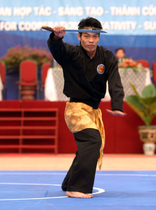
Silat
Silat is a collective word for a class of indigenous martial arts from the geo-cultural area of the Maritime Southeast Asia. It is traditionally practised in Brunei, Indonesia, Malaysia, Singapore, portions of the Philippines, Training halls are overseen by separate national organisations in each of the main countries the art is practised. These organisations are Ikatan Pencak Silat Indonesia (IPSI) from Indonesia, Persekutuan Silat Kebangsaan Malaysia (PESAKA) from Malaysia, Persekutuan Silat Brunei Darussalam (PERSIB) from Brunei and Persekutuan Silat Singapura (PERSISI) from Singapore. Practitioners are called pesilat. Both Pencak Silat and Silat Melayu are recognized as piece of Intangible cultural heritage by UNESCO (United Nations Educational, Scientific and Cultural Organization) in December, 2019.
See all
0
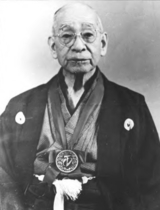
Shōrin-ryū
Shōrin-ryū (少林流) is one of the major modern Okinawan martial arts and is one of the oldest styles of karate. It was named by Choshin Chibana in 1933, but the system itself is much older. The characters 少林, meaning "small" and "forest" respectively and pronounced "shōrin" in Japanese, are also used in the Chinese and Japanese words for "Ryū" means "school". Shōrin-ryū combines elements of the traditional Okinawan fighting styles of Shuri-te.
See all
0

Wing Chun
Wing Chun Kuen , usually called Wing Chun (詠春), is a concept-based traditional Southern Chinese Kung fu (wushu) style and a form of self-defence, also known as "beautiful springtime", that requires quick arm movements and strong legs to defeat opponents. Softness (via relaxation) and performance of techniques in a relaxed manner is fundamental to Wing Chun. According to legend, it was created by Ng Mui, an abbess who taught it to her student Yim Wing-chun as a means to defend herself against unwanted advances. The martial art is named after her. According to Ip Man, "Chi Sau in Wing Chun is to maintain one's flexibility and softness, all the while keeping in the strength to fight back, much like the flexible nature of bamboo". Notable practitioners of Wing Chun include Yuen Kay Shan, Ip Man, Ip Chun, Bruce Lee, Brandon Lee, Jackie Chan, Donnie Yen, Robert Downey Jr and Sum Nung.
See all
0
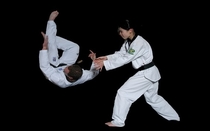
Hapkido
Hapkido (also spelled hap ki do or hapki-do; from Korean hapgido ) is a highly eclectic Korean martial art. It is a form of self-defense that employs joint locks, grappling, and throwing techniques similar to those of other martial arts, as well as kicks, punches, and other striking attacks. It also teaches the use of traditional weapons, including knife, sword, rope, ssang juhl bong (nunchaku), cane (ji pang ee), short stick (dan bong), and middle-length staff (joong bong), gun (analogous to the Japanese jō), and bō (Japanese), which vary in emphasis depending on the particular tradition examined. Hapkido employs both long-range and close-range fighting techniques, utilizing jumping kicks and percussive hand strikes at longer ranges, and pressure point strikes, joint locks, and throws at closer fighting distances. Hapkido emphasizes circular motion, redirection of force, and control of the opponent. Practitioners seek to gain advantage over their opponents through footwork and body positioning to incorporate the use of leverage, avoiding the use of brute strength against brute strength. The art was adapted from Daitō-ryū Aiki-jūjutsu as it was taught by Choi Yong-Sool (최용술) when he returned to Korea after World War II after having lived in Japan for 30 years. This system was later combined by Choi´s disciples with kicking and striking techniques of indigenous and contemporary arts such as Taekkyon, and Tang Soo Do; as well as various throwing techniques and ground fighting from Japanese Judo.
See all
0

Kickboxing
Kickboxing is a group of stand-up combat sports based on kicking and punching, historically developed from karate mixed with boxing. Kickboxing is practiced for self-defence, general fitness, or as a contact sport. Japanese kickboxing originated in the late 1950s, with competitions held since then. American kickboxing originated in the 1970s and was brought to prominence in September 1974, when the Professional Karate Association (PKA) held the first World Championships. Historically, kickboxing can be considered a hybrid martial art formed from the combination of elements of various traditional styles. This approach became increasingly popular since the 1970s, and since the 1990s, kickboxing has contributed to the emergence of mixed martial arts via further hybridization with ground fighting techniques from Brazilian jiu-jitsu and folk wrestling. There is no single international governing body. International governing bodies include the World Association of Kickboxing Organizations, World Kickboxing Association, International Sport Karate Association, International Kickboxing Federation, and World Kickboxing Network, among others. Consequently, there is no single kickboxing world championship, and champion titles are issued by individual promotions, such as Glory, SUPERKOMBAT, ONE FC, K-1 and Kunlun Fight among others. Bouts organized under different governing bodies apply different rules, such as allowing the use of knees or clinching, etc.
See all
0
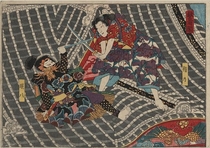
Kenjutsu
is the umbrella term for all (ko-budō) schools of Japanese swordsmanship, in particular those that predate the Meiji Restoration. Some modern styles of kendo and iaido that were established in the 20th century also included modern forms of kenjutsu in their curriculum. Kenjutsu, which originated with the samurai class of feudal Japan, means "methods, techniques, and the art of the Japanese sword." This is opposed to kendo, which means "the way of the sword" and uses a bamboo sword (shinai) and protective armour (bōgu). The exact activities and conventions undertaken when practicing kenjutsu vary from school to school, where the word school here refers to the practice, methods, ethics, and metaphysics of a given tradition, yet commonly include practice of battlefield techniques without an opponent and techniques whereby two practitioners perform kata (featuring full contact strikes to the body in some styles and no body contact strikes permitted in others). Although kata training has always been the mainstay, in later periods, schools incorporated sparring under a variety of conditions, from using solid wooden bokutō to the use of a bamboo sword (shinai) and armor (bōgu). In modern times sparring in Japanese martial art is more strongly associated with kendo and is mainly practiced by students or the police force. Although kendo is common in Japan, it is also practiced in other countries around the world.
See all
0
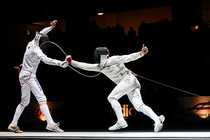
Fencing
Fencing is a group of three related combat sports. The three disciplines in modern fencing are the foil, the épée, and the sabre (also saber); winning points are made through the weapon's contact with an opponent. A fourth discipline, singlestick, appeared in the 1904 Olympics but was dropped after that, and is not a part of modern fencing. Fencing was one of the first sports to be played in the Olympics. Based on the traditional skills of swordsmanship, the modern sport arose at the end of the 19th century, with the Italian school having modified the historical European martial art of classical fencing, and the French school later refining the Italian system. There are three forms of modern fencing, each of which uses a different kind of weapon and has different rules; thus the sport itself is divided into three competitive scenes: foil, épée, and sabre. Most competitive fencers choose to specialize in one weapon only. Competitive fencing is one of the five activities which have been featured in every modern Olympic Games, the other four being athletics, cycling, swimming, and gymnastics.
See all
0
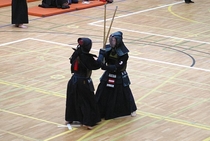
Kendo
is a traditional Japanese martial art, which descended from swordsmanship (kenjutsu) and uses bamboo swords (shinai) and protective armour (bōgu). Today, it is widely practiced within Japan and many other nations across the world. Kendo is an activity that combines martial arts practices and values with strenuous sport-like physical activity.
See all
0

Ninjutsu
sometimes used interchangeably with the modern term is the strategy and tactics of unconventional warfare, guerrilla warfare and espionage purportedly practiced by the ninja. Ninjutsu was a separate discipline in some traditional Japanese schools, which integrated study of more conventional martial arts (taijutsu) along with shurikenjutsu, kenjutsu, sōjutsu, bōjutsu and others. While there is an international martial arts organization representing several modern styles of ninjutsu, the historical lineage of these styles is disputed. Some schools claim to be the only legitimate heir of the art, but ninjutsu is not centralized like modernized martial arts such as judo or karate. Iga Ryu claims to be the oldest recorded form of ninjutsu, and claims to have survived past the 16th century.
See all
0
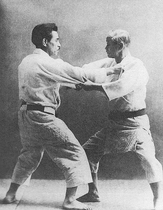
Judo
is generally categorized as a modern martial art, which has since evolved into a combat and Olympic sport. The sport was originally created in 1882 by Jigoro Kano (嘉納治五郎) as a physical, mental, and moral pedagogy in Japan. Judo's most prominent feature is its competitive element, where the objective is to either throw or take down an opponent to the ground, immobilize or otherwise subdue an opponent with a pin, or force an opponent to submit with a joint lock or a choke. Strikes and thrusts by hands and feet as well as weapons defences are a part of judo, but only in pre-arranged forms (kata, 形) and are not allowed in judo competition or free practice (randori, 乱取り). A judo practitioner is called a judoka. The philosophy and subsequent pedagogy developed for judo became the model for other modern Japanese martial arts that developed from . Judo also spawned a number of derivative martial arts across the world, such as Brazilian jiu-jitsu, Krav Maga and Sambo.
See all
0

